Disturbed by the Kolis' gradual loss of occupation, habitat and culture, Parag Tandel turns a fish recipe book into an illustrative tool to comment on the drying up of indigenous resources
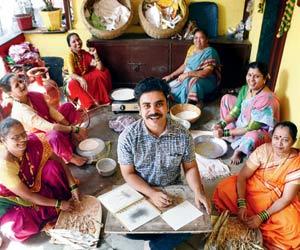
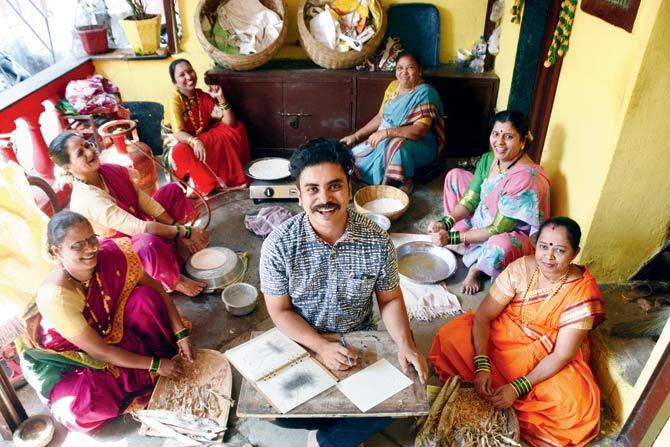
As Koli women of Chendani, Thane, make rice bhakris, artist Parag Tandel draws on their shift of occupation and lifestyle. Pics/Sneha Kharabe
 A hand-written archive of dry fish recipes jotted down by 13 women of Chendani Koliwada in Thane, has managed a rather unimaginable journey. After a brief appearance at an exhibition titled Autopolisphilia (fixation with the city that one lives in), the untitled manuscript is back to the koliwada where visual artist and sculptor Parag Tandel, 39, is devising ways to use the preparations as a prism to understand the raw anarchic-yet-endearing connect Koli women share with seafood.
A hand-written archive of dry fish recipes jotted down by 13 women of Chendani Koliwada in Thane, has managed a rather unimaginable journey. After a brief appearance at an exhibition titled Autopolisphilia (fixation with the city that one lives in), the untitled manuscript is back to the koliwada where visual artist and sculptor Parag Tandel, 39, is devising ways to use the preparations as a prism to understand the raw anarchic-yet-endearing connect Koli women share with seafood.
ADVERTISEMENT
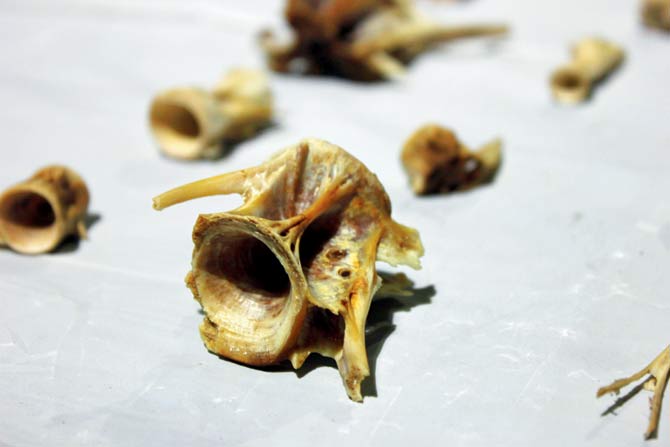
A sample of the mummified fish used in the project Ek Bagal Mein Chand
The book, illustrated by Tandel with black-and-white drawings on archival paper, is not a book in the true sense of the term. It is a dense web of cultural references gathered for Tandel's ongoing project, Ek Bagal Mein Chand Hoga Ek Bagal Mein Rotiyan (One Side Lies The Moon, On The Other Lies The Bread), that underscores the collective sense of loss over the drying of resources, habitat, vegetation and trade of Mumbai's oldest inhabitants. For Tandel, diminishing fish supply signifies the depletion of resources; it means a loss, and yet the action itself suggests the need to preserve. Offering a spin on the word and the action, he wants to revive many more Koli delicacies that are no longer prepared. With the diversity of fish available to us shrinking because of environmental degradation, the process of mummification and drying of fish runs the risk of becoming extinct. Earlier, fisher folk would dry up to 33 species of fish, Tandel says. These are now down to a handful.
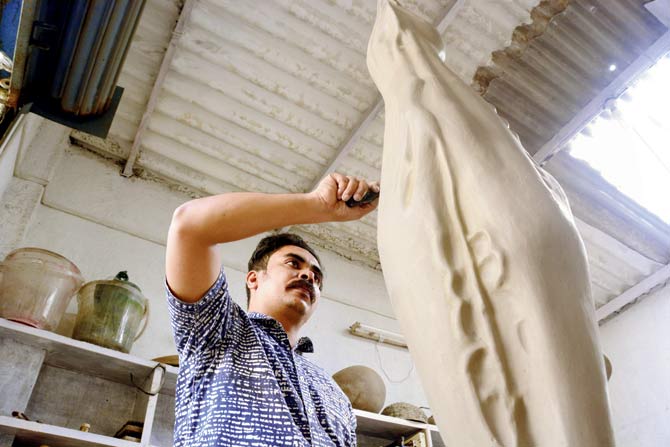
Parag Tandel at work on a sculpture modelled on a fish bone
Tandel sees a world of opportunity in the 13 niche narratives, written in elementary Marathi. These are not mere recipe formulae, but concise introductions of resilient women who have adapted to the pressures of living in Maximum City. Matriarch Bhoomika Koli, 73, has a repository of little-known recipes, including Nital, a curry of bombil cooked in coconut milk. Record-breaker Kanchan Ganesh Koli, 45, uses the pneumatic press machine to make 1000 bhakris every day, catering to 15 restaurants in Thane and Kalwa. While the running rate per bhakri ranges between R10 and R15, it can rise on long weekends when rice modaks are added to the fare. Tandel wants to document this economics of the bhakri, along with oral histories of women and men, some of whom are residents of Mumbai's koliwadas since pre-Independence. He is slated to make a presentation at the Central Institute of Fisheries Education, Versova, where he hopes to share key insights into contemporary Koli life.
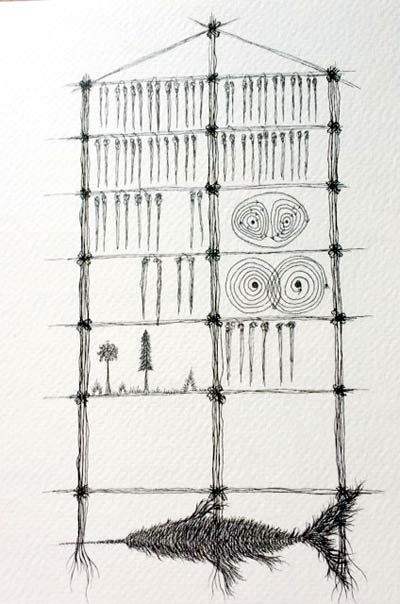
Tandel's sketch of a dystopian Koli landscape where both ecological and cultural resources are drying
The bhakri, the Maharashtrian version of the roti, made from jawar, rice or bajri, has fascinated Tandel for long. Circular bhakris attain a symbolic meaning in his art practice. He has played with their shape, size and texture in public art interventions like Daily Rations organised by ArtOxygen in 2017. Bhakris were also central to the recipe contest and the exhibition of mummified fish that he mounted in Chendani Koliwada, with curator Leandre D'Souza in November, 2017. He sees the wholesale bhakri-making activity as a signal of social transition, and not one that's necessarily for the better. Rice bhakris are served to fine dine seafood joints, who in turn vend them in the name of Koli exotica. This signifies the growing clientele for Koli-Agri gavran fare.
Tandel has a problem with the marketing of 'rustic' Koli food, as it raises the crucial question about an unregistered work force. "While Koli women are paid instant cash, and this aids many families, doesn't it also give birth to a new work culture? Women break their backs making bhakris with their hands. Some run the risk of spondylitis after following this regimen for 20 years. The gruelling nature and commercial scale of this business has health implications, which necessitate the setting up of industry parameters," he thinks. Tandel sees this as a reversal of livelihood options, in which an ancillary activity has become a core occupation.
His 52 drawings for the exhibition named Autopolisphilia, and others in the book, inspired by his mapping of the dry fish recipes using visual language, denote a dystopian Koli habitat where Mumbai's original inhabitants have been compelled to discard indigenous life and embrace coping mechanisms. His imagery is open to interpretation. A few black rising suns in one frame could resemble quantum physics objects, but they can also be the various phases of the sun during the day. He has not glass-cased the works, leaving them deliberately exposed to a tactile experience. In surreal and subtle strokes, he denotes the impact of indiscriminate development on seascapes, rainfall, fishing bays and fisher folk. Haphazard construction is a recurring theme he references, particularly the loss of identity in koliwadas, especially the concretised ones at Sion and Sewri. Tandel rues the loss of mango farms and rice fields along the Thane Ghodbunder Road stretch. "The most profitable business for the Kolis and other land-holding communities in Thane these days is selling land. Most of them have no idea where to invest these astronomical sums. They splurge and make merry after the deal is struck, and often have to later take up menial jobs like offering security to buildings that came up on the very land they once owned," he says.
Curator Noopur Desai, who showcased Tandel's Autopolisphilia in Pune last month at Sudarshan Art Gallery, feels he is among the few who has effectively nailed the present-day Koli reality, by including both ecological and cultural destruction, and steering clear of stereotypes. In the upside-down oblique topography he paints, accentuated by repetition of fine lines, the big fish are skeletal forms under the sea. "The forms bulge and become prominent in the narrative; they resemble a submarine bomber or even a big capsule. The engagement is at multiple levels," Desai says. The altered landscape reflects in suspended water-bodies, uprooted trees, corroded mountains, built spaces or floating plots of land and of course, disappearing mangroves. Tandel wants to invoke a feeling of alienation and displacement, and yet treasure his cultural links with the original non-urbanized geography where Kolis followed the lunar calendar, sold luscious fish, and spoke a lingo that is now extinct.
As the painter-documenter, and JJ School of Art alumni, scales up the Ek Bagal Mein Chand engagement with his bhakri-making neighbourhood, he also plans solo shows in unrelated spaces which do not have an obvious Koli connect, outside the typical Mumbai art circles. "I believe in an ad hoc show series. Why not have a show in Baroda and then one in Satara?" he adds. Tandel calls his works "thinking drawings" - his take rests on the universal tension between the erected (built) and the natural environment. He draws the emerging topography that we are contributing to, but haven't dared to have a preview of.
Sumedha Raikar-Mhatre is a culture columnist in search of the sub-text. You can reach her at sumedha.raikar@gmail.com
Catch up on all the latest Mumbai news, crime news, current affairs, and also a complete guide on Mumbai from food to things to do and events across the city here. Also download the new mid-day Android and iOS apps to get latest updates
 Subscribe today by clicking the link and stay updated with the latest news!" Click here!
Subscribe today by clicking the link and stay updated with the latest news!" Click here!







